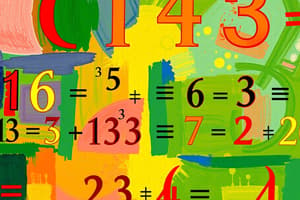Podcast
Questions and Answers
What is the formula to find the nth term in an arithmetic sequence?
What is the formula to find the nth term in an arithmetic sequence?
a_n = a_1 + (n-1)d
In the sequence 2, 5, 8, 11, what is the common difference?
In the sequence 2, 5, 8, 11, what is the common difference?
3
Calculate the third term in the sequence 2, 5, 8, 11.
Calculate the third term in the sequence 2, 5, 8, 11.
8
What do arithmetic sequences model in real-world applications?
What do arithmetic sequences model in real-world applications?
What is the common difference in the sequence 3, 7, 11, 15?
What is the common difference in the sequence 3, 7, 11, 15?
What is the explicit formula for finding the nth term of an arithmetic sequence?
What is the explicit formula for finding the nth term of an arithmetic sequence?
How can the explicit formula be alternatively expressed to find the nth term?
How can the explicit formula be alternatively expressed to find the nth term?
What is the formula for the sum of the first n terms in an arithmetic sequence?
What is the formula for the sum of the first n terms in an arithmetic sequence?
How are arithmetic sequences with a common difference of 0 classified?
How are arithmetic sequences with a common difference of 0 classified?
What term is used to describe arithmetic sequences with a common difference of 1?
What term is used to describe arithmetic sequences with a common difference of 1?
Study Notes
Arithmetic Sequences: Exploring Patterns and Sums
An arithmetic sequence is a series of numbers where each term is obtained by adding a fixed amount called the common difference to the previous term. Let's delve into the essence of arithmetic sequences, covering their key features and applications.
Nth Term
In an arithmetic sequence, the nth term (_a_n) can be calculated using the first term (_a_1) and the common difference (d):
[ a_n = a_1 + (n-1)d ]
For example, in the sequence 2, 5, 8, 11, the first term is 2, and the common difference is 3. The third term would be 2 + (3-1) * 3 = 8.
Common Difference
The common difference (d) is the value that is added to the previous term to obtain the next term in the sequence. For instance, in the sequence 2, 5, 8, 11, the common difference is 3.
Applications
Arithmetic sequences have numerous real-world applications. For instance, they can model the growth of populations, the expansion of a business, or the accumulation of interest.
Explicit Formula
The explicit formula for an arithmetic sequence, as mentioned earlier, is:
[ a_n = a_1 + (n-1)d ]
However, it is also possible to find the nth term by using the formula:
[ a_n = a_1 + (n-1)(a_n - a_1) / 1 ]
which simplifies to:
[ a_n = \frac{n}{2}(a_1 + a_n) - \frac{n-1}{2}a_1 ]
Sum of Terms
The sum of the first n terms in an arithmetic sequence can be calculated using the formula:
[ S_n = \frac{n}{2}(a_1 + a_n) ]
This formula is based on the fact that the first and last terms add together with the sum of all the n-1 remaining terms, which can be calculated by multiplying the common difference by the number of terms and dividing by 2.
Special Cases
Arithmetic sequences can also be classified into several special cases based on their first term and common difference. For instance, arithmetic sequences with d = 0 correspond to constant sequences, and those with d = 1 correspond to arithmetic progressions.
Conclusion
Arithmetic sequences are a fundamental concept in mathematics, providing a basis for understanding more complex sequences and series. An appreciation of arithmetic sequences and their properties can lead to improved understanding of both theoretical and practical concepts.
Studying That Suits You
Use AI to generate personalized quizzes and flashcards to suit your learning preferences.
Description
Delve into the essence of arithmetic sequences, covering key features like nth term calculation, common difference, real-world applications, explicit formula, sum of terms, and special cases. Understand the fundamental concept of arithmetic sequences and their importance in mathematics.




